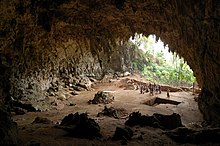
Rampasasa pygmies is a name given to a group of families described as pygmoid or Negrito, native to Waemulu village in Kecamatan Wae Rii, Manggarai Regency, Flores, Indonesia, following the discovery of Homo floresiensis in the nearby Liang Bua cave in 2003.
The Rampasasa have since been reported as claiming Homo floresiensis as their ancestor and as "cashing in on hobbit craze".
A genetic study published in 2018 discounted the possibility of the Rampasasa descending from H. floresiensis, concluding that "multiple independent instances of hominin insular dwarfism occurred on Flores". However, as no genetic material from H. floresiensis was included in the analyses, any truly definitive conclusions cannot be made.
References
- Gregory Forth, Images of the Wildman in Southeast Asia: An Anthropological Perspective, Routledge (2008), p. 432.
- Maciej Henneberg, Robert B Eckhardt, John Schofield, The Hobbit Trap: How New Species Are Invented, Routledge (2016), p. 87.
- Michael Casey, Associated Press, 3 September 2010 "Indonesian villages cashing in on 'hobbit' craze
- Science magazine Vol. 361, Issue 6401 (3 Aug 2018), pp. 511-516 sciencemag.org
- Goldenberg, Linda (2007). Little People and a Lost World: An Anthropological Mystery, 90f.
External links
- John Noble Wilford (August 22, 2006). "Report Reignites Feud Over 'Little People of Flores'". The New York Times. Retrieved 20 May 2017.
- ""Hobbits" Were Pygmy Ancestors, Not New Species, Study Says". National Geographic. National Geographic Society. August 21, 2006. Archived from the original on November 18, 2006. Retrieved 20 May 2017.
8°32′S 120°27′E / 8.533°S 120.450°E / -8.533; 120.450
Categories: